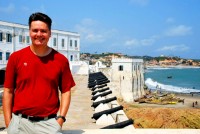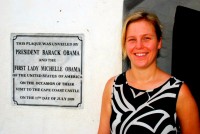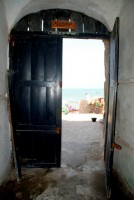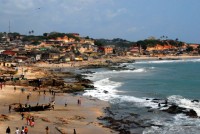Christi and I have just enjoyed our last night in a hotel bed for 5 weeks (upgrades are possible, but not on our budget!). Unfortunately, neither of us slept well as we are still bedeviled by jet lag. My first job on the Dragoman trip is to help gerrymander 18 pieces of luggage into the rear storage locker. And I will continue to do so with the help of two other passengers twice a day for next 35 days. What a thrill. Our first Dragoman adventure lies 3 hours to the west of Accra at Cape Coast Castle. A European settlement has existed on this site since 1653, although the current incarnation was built by the British in the 18th century. Cape Coast Castle is one of about 30 slave forts built on the Gold Coast of Africa. Numerous colonial powers claimed ownership over the Gold Coast over the years, the last of which were the British (which probably explains why Ghanaians all speak English while the lingua franca of West Africa is usually French). Indeed, it was only in 1957 that Britain granted the Gold Coast its independence, creating present day Ghana. The castle actually sits in a beautiful location overlooking the azure waters of the Atlantic. On the surrounding beach eager fishermen go about their daily business – there’s a frisson of energy and excitement about the place.
Historically, the Gold Coast was exploited for its abundance of gold, ivory, timber, and spices. But when the colonial powers of Spain and Portugal exhausted the supply of indigenous labor to mine silver (Potosi) and gold (Ouro Prêto) in the New World, African slaves were seen as an ideal substitute and there was an almost inexhaustible supply of them. The fact that Cape Coast Castle is such an imposing and heavily armed fortification offers a stark reminder that exploiting Africa and defending this wealth-creating environment from the other colonial powers was big business.
As we tour the castle, our guide tells us that the slave cells were originally storage rooms designed to hold ivory, gold, spices, etc. However when the slave trade took off these same storage rooms, which had no beds, no toilets, and very little light were used as holding cells for slaves awaiting transportation to the New World. One thousand men were forced into 5 cramped holding cells and if you defecated you had to sit in it as there was nowhere else to go. With little food and poor sanitary conditions it’s not surprising that only half the prisoners survived until the slave ships came to transport them to the Americas, the so-called Middle Passage. At the same time 300 women were kept in 2 separate holding cells. These girls were routinely raped by their guards, while girls that became pregnant on the long sea voyages were often tossed overboard and left to drown. The slaves left Cape Coast Castle via the Door of No Return. This was the last view they would ever have of their homeland.
When Christi and I embarked upon our Year of Wonder, we did not consciously decide to follow the slave trail, but having experienced the atrocious exploitation of these West Africans, one cannot help but feel empathy for the slaves and shame for the actions of our ancestors. To know that this beautiful location housed such pain and suffering is a sobering and disconcerting feeling.
One of the disadvantages to any organized tour is the enforced schedule and we have to leave before we can finish exploring the nearby fishing village. Perhaps today that’s not such a bad thing. We head inland and will spend our first night under the stars in Kakum National Park. Unloading the damn bags off the truck is my first chore and then I help Christi put up our tent (and both of these chores take a lot longer to do than to write about).
Blog post by Roderick Phillipa, author of Weary Heart – a gut-wrenching tale of broken hearts and broken test tubes.







Speak Your Mind